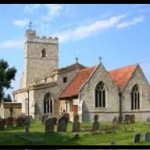Main Branch site:

The Branch web site contains up to date information about ringing in North Bucks. Much of the information formerly in this site can now be found there.
Latest on this site:
Correction of Old Bradwell harmonics and trapezoid measurements and addition of inscriptions and photos of bells - April 2025
Adjustment of trapezoid image scaling to show top of long waisted bells - April 2025
New photos of Emberton's bells, treble inscription and 1899-1901 timeline adjusted - May 2025
|
| |
Fastest peal
|
Longest peal(s)
|
Branch events here:
| December 19, 2015 | Branch Practice & Xmas Social | |
| July 12, 2014 | Joint Striking competition | |
| November 1, 2013 | Call Changes and Plain Hunt Practice | |
| May 18, 2013 | Branch Surprise Practice | It is anticipated that we will ring Cambridge and Yorkshire Major and as many others of the standard eight surprise major methods as possible. |
| November 4, 2011 | Rounds and Call Change Practice | |
| May 14, 2011 | Branch Practice | |
| January 19, 2007 | Branch Practice | Special method: Bristol S Major & Stedman Triples |
| November 19, 2004 | Branch Practice | |
| January 17, 2003 | Branch Practice | Belfast S Major |
| November 17, 2000 | Branch Practice | Yorkshire S Major |
|
 |
| Description | From The Ringing World 6 July 1951 |
| Approx Date | 1882 |
| Full report | GREAT PAUL. - To enable readers to compare the respective size and shape of Great George with Great Paul of St. Paul's Cathedral, we are privileged through the permission of Mr. S. F. Markham to publish a picture of this famous bell taken on its journey from the foundry at Loughborough to London in 1882. Great Paul is the heaviest bell in the United Kingdom and weighs 16 tons 14 cwt. 2qr. 19 lb. On its journey to London the trolley conveying it was stuck in the mud three days. Great George is the second heaviest bell in this country. |
|
|
|
Who has circled the tower to peals:
| Andrew Haseldine |
| Malcolm G Hooton |
Who has rung the most peals here:
| Andrew Haseldine | 36 | February 22, 2020 |
| Julie A Haseldine | 28 | February 22, 2020 |
| Richard Haseldine | 28 | November 14, 2017 |
| Christopher C Stokes | 22 | February 17, 2018 |
| Thomas C Tompkins | 19 | December 21, 1935 |
| Ruth Stokes | 19 | February 22, 2020 |
| Edwin A Yates | 17 | May 26, 1932 |
| Malcolm G Hooton | 17 | November 27, 2001 |
| George E Green | 16 | January 18, 2003 |
| Herbert C Edwards | 15 | October 13, 1956 |
|
| 1 | | | Flat of F by 23 cents | 3 - 3 - 18 | 25⅞ | Taylor in 1923 |
| 2 | | | Flat of E by 27 cents | 4 - 1 - 14 | 27½ | Taylor in 1923 |
| 3 | | | Flat of D by 23 cents | 5 - 0 - 12 | 30 | Taylor Oxford in 1838 |
| 4 | | | Flat of C by 19 cents | 4 - 3 - 10 | 30¾ | Taylor Oxford in 1838 |
| 5 | | | Flat of A#/Bb by 18 cents | 5 - 3 - 26 | 33¼ | Taylor Oxford in 1838 |
| 6 | | | Flat of A by 18 cents | 7 - 0 - 15 | 35⅝ | Taylor Oxford in 1838 |
| 7 | | | Flat of G by 14 cents | 8 - 0 - 27 | 38¼ | Taylor Oxford in 1838 |
| 8 | G | Dove | Flat of F by 12 cents | 12 - 1 - 16 | 42 | Taylor Oxford in 1838 |
The figures below show the difference, in cents, between each bell and what it should be to be in tune with the tenor.
A positive figure shows that the bell is sharp, a negative figure shows that it is flat. There are 100 cents between notes on the scale.
| 1 | 3 |
| 2 | -4 |
| 3 | -3 |
| 4 | -1 |
| 5 | -3 |
| 6 | -5 |
| 7 | 0 |
| 8 | 0 |

History of bells in this tower:
| | 1 of 8, John Taylor & Co, 1923 |
| | 2 of 8, John Taylor & Co, 1923 |
| 1 of 6, W & J Taylor, 1837 | 3 of 8, W & J Taylor, 1837 |
| 2 of 6, W & J Taylor, 1837 | 4 of 8, W & J Taylor, 1837 |
| 3 of 6, W & J Taylor, 1837 | 5 of 8, W & J Taylor, 1837 |
| 4 of 6, W & J Taylor, 1837 | 6 of 8, W & J Taylor, 1837 |
| 5 of 6, W & J Taylor, 1837 | 7 of 8, W & J Taylor, 1837 |
| 6 of 6, W & J Taylor, 1837 | 8 of 8, W & J Taylor, 1837 |
|
Classification from "Bellframes - A Practical Guide to Inspection and Recording - C J Pickford 1993"
|
|